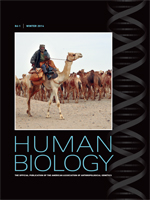The Rama Amerindians from southern Nicaragua are one of few indigenous populations inhabiting the east coast and lowlands of southern Central America. Early-eighteenth-century ethnohistorical accounts depicted the Rama as a mobile hunter-gatherer and horticulturalist group dispersed in household units along southern Nicaraguan rivers. However, during the nineteenth and twentieth centuries, Rama settlement patterns changed to aggregated communities because of increased competition for local resources resulting from nonindigenous immigration. The objective of this study was to discern the degree of relatedness between and within subdivisions of seven of these communities based on patterns of surname variation and genealogical data. We applied surname analyses (n = 592) to evaluate inter-and intrapopulation variation, consanguinity and substructure estimates, and isolation by distance and used a genealogically based marital migration matrix obtained during fieldwork in 2007 and 2009 to better understand internal migration. Our evaluation indicates a pattern of geographic distribution linking kinships in major subpopulations to nearby family-based villages. Mantel tests provide a correlation (r = 0.4;p < 0.05) between distance matrices derived from surname and geography among Rama communities. Genealogical analysis reveals a pattern of kin networks within both peripheral and central populations, consistent with previous genetic investigations, where the Amerindian mitochondrial DNA haplogroup B2 is commonly found among peripheral communities and A2 is frequent in central subpopulations. Marital migration and genealogies provide additional information regarding the influx of non-Ramas to communities near populated villages. These results indicate that the disruption of the Rama's traditional way of life has had significant consequences on their population structure consistent with population fissions and aggregations since the eighteenth century.
How to translate text using browser tools
1 February 2014
Effect of Recent Historical Events on Migration and Isonymic Stratification among the Rama Amerindians from Nicaragua
Norberto F. Baldi,
Phillip E. Melton,
Michael H. Crawford
ACCESS THE FULL ARTICLE

Human Biology
Vol. 86 • No. 1
February 2014
Vol. 86 • No. 1
February 2014
CARIBBEAN CENTRAL AMERICA
ISONYMIC ANALYSES
migration
population structure
RAMA AMERINDIANS




